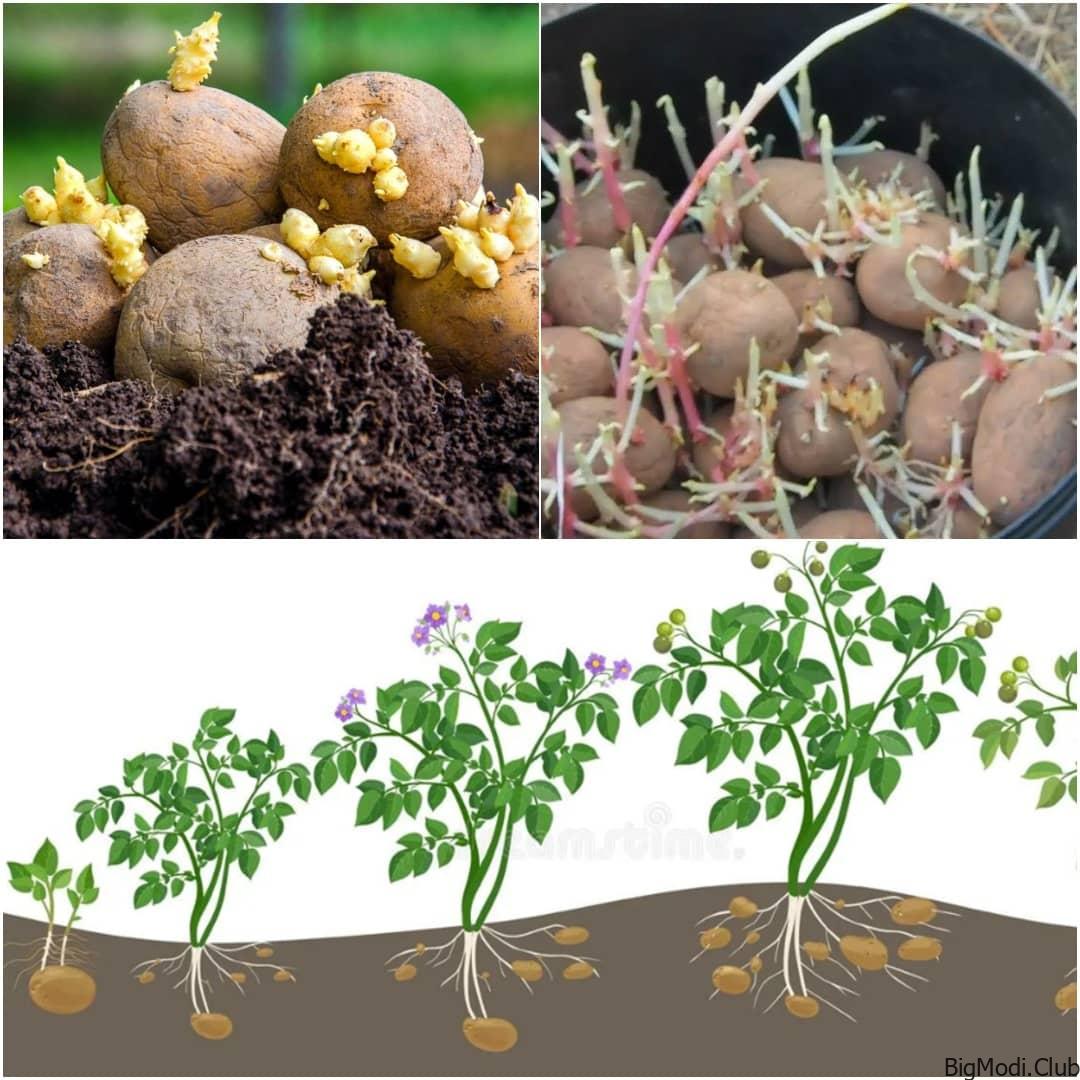If you’re like me, the moment you plant seed potatoes, you start dreaming about the fresh, tender tubers you’ll be harvesting in a few months. But how long do potatoes take to grow? Patience is key since potatoes are considered a long-season crop. Typically, potatoes take between 70 to 130 days to mature depending on the variety and growing conditions. Let’s break down the potato-growing timeline and learn how you can speed up the process for an earlier harvest.
Potatoes are a popular crop for home gardeners, offering a rewarding harvest if you’re willing to wait. Understanding how long potatoes take to grow and the factors that influence their development is key to a successful potato-growing experience. Let’s dive into all the details, from the types of potatoes to the growth stages and everything in between.
General Growing Time for Potatoes
The amount of time potatoes take to grow varies depending on the variety. In general, the potato growing season ranges from three to four months, or 70 to 130 days. Here’s a breakdown based on the type of potato:
Early Season Potatoes
Early season potatoes, often called new potatoes, mature in 70 to 90 days. These potatoes are great if you’re looking for a faster harvest. Their thin skins make them perfect for eating fresh without needing to peel.
Mid-Season Potatoes
Mid-season potatoes take about 90 to 110 days to mature. They offer a balance between early harvests and larger tubers. Yukon Gold and French Fingerling are examples of mid-season varieties.
Late Season Potatoes
Late season potatoes, also known as storage potatoes, need a longer growing period, typically 110 to 130 days. These varieties, such as All Blue and Kennebec, are ideal if you plan to store your harvest through the winter.
Factors Affecting Potato Growth Time
Several factors influence how long potatoes take to grow. Understanding these can help you optimize your growing season and avoid delays.
Climate and Weather Conditions
Potatoes thrive in mild weather conditions. Cold, wet springs can slow down the sprouting process, while excessive heat can stress the plants and limit tuber formation.
Soil Quality
Well-drained, loose, and fertile soil encourages faster potato growth. Potatoes struggle in heavy clay soils or those that retain too much moisture, which can lead to rotting tubers.
Growth Stages of Potatoes
Potatoes grow through several distinct stages, each critical to their development. Here’s a closer look at the timeline:
Stage 1: Emergence
This stage occurs 2 to 4 weeks after planting. The seed potatoes sprout and emerge from the soil, signaling the beginning of the growing cycle.
Stage 2: Vegetative Growth and Tuber Formation
After emergence, vegetative growth and tuber formation begin 2 to 4 weeks later. During this time, the plant focuses on establishing roots and forming small tubers underground.
Stage 3: Tuber Bulking
Tuber bulking happens between 6 to 12 weeks after emergence. The tubers start to increase in size, and the plants may flower. Watering is crucial during this stage to ensure healthy tuber development.
Stage 4: Tuber Maturity
Around 12 to 16 weeks after emergence, the tubers are fully mature and ready for harvest. This stage marks the end of the potato-growing cycle.
Growing Potatoes in Different Locations
The location where you plant your potatoes plays a crucial role in determining how long they will take to grow. Let’s delve into the specifics of growing potatoes in three different settings: in-ground gardens, raised beds, and containers.
How Long Does It Take for Potatoes to Grow in an In-Ground Garden?
Spring Weather Considerations: In areas where spring weather is typically cold and wet, you need to be patient. Planting potatoes in soil that is still cold and saturated with moisture can cause delays. This adverse condition can hinder sprouting or even lead to the rotting of seed potatoes. To avoid these issues, wait until the soil has warmed up and dried out sufficiently. This precaution often translates to a planting delay of one to two weeks.
Ideal Conditions for In-Ground Gardens: Potatoes thrive in garden beds that enjoy full sunlight and feature loose, well-draining soil. Imagine a garden bed that soaks up the sun’s rays and allows excess water to drain away effortlessly—this is the ideal setting for growing robust potato plants.
Planting and Growing Time: In an in-ground garden, the time from planting to harvest typically ranges from 70 to 130 days. This variation depends on the type of potato and its specific variety. For instance, early-season varieties might reach maturity quicker than late-season ones.
How Long Does It Take for Potatoes to Grow in Raised Beds?
Advantages of Raised Beds: Raised beds offer several benefits that can positively impact your potato growing experience. They warm up faster in the spring, thanks to their elevated structure, which enhances soil temperature. They also feature loose, deep soil and excellent drainage, setting the stage for a head start in the growing season.
Planting and Growing Time: Even with these advantages, if you plant the same potato variety in both raised beds and in-ground gardens, the time to harvest remains fairly consistent. Potatoes grown in raised beds generally take between 70 to 130 days from planting to harvest. The benefit of raised beds is primarily in their ability to get you started earlier, but the total growth time doesn’t drastically differ from traditional garden beds.
How Long Does It Take for Potatoes to Grow in Containers?
Growing in Containers: Growing potatoes in containers is an excellent option for those with limited space or those who prefer gardening on a patio or deck. You can use various types of containers such as plastic pots, fabric bags, old barrels, or even potato towers. A five-gallon bucket can also serve as a suitable container, provided you add drainage holes to prevent waterlogging.
Advantages of Container Growing: Containers provide the advantage of controlling soil quality more precisely and heating up more quickly due to their exposure to sunlight. This quicker heating can promote faster growth. However, it’s crucial to stay vigilant with watering, as containers tend to dry out faster than garden beds.
Varieties for Containers: When growing potatoes in containers, the choice of variety can influence your results. Early-season potatoes mature more quickly but yield a smaller crop. On the other hand, mid-season and late-maturity varieties are more suited to containers as they can produce tubers over an extended period, making better use of the available space.
Growing Time: Potatoes grown in containers typically take 90 to 130 days to be ready for harvest, depending on the variety you choose. This timeframe is slightly longer compared to some in-ground or raised bed varieties but can be managed with the right approach to container care.
How to Speed Up Potato Growth
Impatient for your potato harvest? Here are a few strategies to encourage faster growth:
- Plant disease-free seed potatoes to avoid plant diseases that can slow growth.
- Chit your seed potatoes before planting to give them a head start.
- Choose early-maturing varieties for a faster harvest.
- Ensure adequate sunlight and use compost or manure to boost soil fertility.
- Protect early plantings from frost using row covers or mini tunnels.
Best Potato Varieties for Early Harvest
Choosing the right potato variety can also impact your growing timeline. Here are some of the best varieties for early harvests:
Norland
An early-season variety, Norland potatoes mature in 70 to 90 days. They are known for their thin skin and tender texture.
Yukon Gold
A popular mid-season variety, Yukon Gold potatoes take about 90 to 110 days to mature and are known for their buttery flavor.
All Blue
For a colorful addition to your garden, All Blue potatoes are a late-season variety that matures in 110 to 130 days.
How to Care for Potatoes During Growth
Caring for your potato plants is crucial to ensure a healthy and productive harvest. Here are some tips:
Watering and Irrigation
Potatoes need consistent moisture, especially during the tuber bulking stage. Deep watering once a week is recommended if rainfall is insufficient.
Fertilizing Your Potatoes
Potatoes are heavy feeders and benefit from an organic granular fertilizer application when the plants reach about a foot tall. Be sure to use a balanced fertilizer to support healthy growth.
Harvesting Potatoes
Signs Your Potatoes Are Ready
Your potatoes are ready to harvest when the plant’s foliage starts to die back. This typically happens around the 12 to 16-week mark, depending on the variety.
How to Properly Harvest Potatoes
Use a garden fork or shovel to gently lift the plants from the soil, taking care not to damage the tubers. Shake off any excess soil and let the potatoes air dry before storing.
Storing Your Potato Harvest
Once harvested, potatoes can be stored in a cool, dark place for several months. Be sure to avoid exposing them to light, which can cause them to turn green and develop toxic compounds.
Common Problems and Solutions When Growing Potatoes
Late Blight
Late blight is a fungal disease that can affect potatoes, particularly in wet conditions. To prevent it, ensure your plants have good air circulation and avoid overwatering.
Rotting Tubers
Rotting tubers are often a result of overly wet soil. Plant potatoes in well-drained soil and avoid overwatering to prevent this issue.
FAQs
- What is the fastest potato variety to grow?
Early-season varieties like Norland are among the fastest, maturing in just 70 to 90 days. - How can I speed up potato growth?
You can speed up growth by chitting your seed potatoes, planting early-maturing varieties, and ensuring optimal growing conditions. - Do potatoes need full sun to grow?
Yes, potatoes thrive in full sunlight, requiring at least 6 hours of direct sun per day. - Can I grow potatoes in containers successfully?
Yes, potatoes can be grown in containers. Containers offer flexibility in small spaces, and while yields might be smaller, they are ideal for urban gardening or limited areas. Ensure the container has drainage holes and choose the right potato variety for better results. - How do I know when it’s time to harvest my potatoes?
Potatoes are ready to harvest when the plant’s foliage starts to die back. Typically, this occurs about 12 to 16 weeks after planting, depending on the variety. Check for mature tubers by gently digging around the base of the plant.


